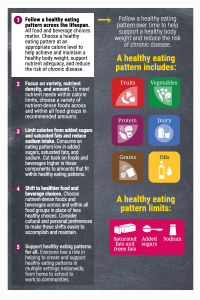 The 8th edition of the Dietary Guidelines for Americans are a welcome change! Instead of the previous editions focusing on individual food groups, the 2015-2020 Dietary Guidelines now focus on healthy eating patterns’ food and nutrient characteristics. When I work with clients, I repeatedly emphasize the importance of balanced meals with good combinations of complex carbs (whole grains, fruits and veggies), lean protein (fish, poultry, beans, lean cuts of pork and red meat) and heart healthy fats (olive oil, nuts, seeds, and avocados). This daily combination can minimize risks for chronic diseases such as diabetes, obesity, high blood pressure and heart disease. It is exciting to see that the Dietary Guidelines now emphasize this sort of balanced nutrition as well.
The 8th edition of the Dietary Guidelines for Americans are a welcome change! Instead of the previous editions focusing on individual food groups, the 2015-2020 Dietary Guidelines now focus on healthy eating patterns’ food and nutrient characteristics. When I work with clients, I repeatedly emphasize the importance of balanced meals with good combinations of complex carbs (whole grains, fruits and veggies), lean protein (fish, poultry, beans, lean cuts of pork and red meat) and heart healthy fats (olive oil, nuts, seeds, and avocados). This daily combination can minimize risks for chronic diseases such as diabetes, obesity, high blood pressure and heart disease. It is exciting to see that the Dietary Guidelines now emphasize this sort of balanced nutrition as well.
In the days following the release of the Dietary Guidelines, there were several great articles highlighting the main points of the guidelines. Two of my favorites are as follows:
Top 10 Things You Need to Know About the 2015-2020 Dietary Guidelines by ODPHP
New Dietary Guidelines: What Changed and What Stayed the Same by Kris Sollid, RD
Upon my own review of the Guidelines, I have come to find that the following recommendations are my favorites:
- Removal of limit on dietary cholesterol. Cholesterol for years has had the bad rap. In actuality, saturated fat plays a bigger role in the rise of blood cholesterol levels. So this means that eggs are once again a good food to eat, which is comforting to see. Eggs provide a complete source of protein that is relatively low in fat and high in iron, which is good for your blood.
- Added sugars should be no more than 10% of your total calories per day. While I really like that added sugar has finally been addressed, more work on this subject is needed in order to help the general public understand what exactly added sugar means and how to determine it on food labels. Right now, food labels do not differentiate between added sugar and sugar that comes from the addition of fruits and milk into food products. But it is a start, and I am excited to see where this recommendation will take the food industry in the future.
- Focus on healthy eating plans tailored to work for you! I really like this one, because it takes into account people’s cultures, ethic traditions, and budget. This is the cornerstone of the meal plans that I design for my clients. I try really hard to encourage my clients to choose healthy foods that meet their food preferences and budgets. For I truly believe, the more you get excited about your food, the more likely you will stick with your healthy meal plan.
- Focus on making small changes over the course of time. Just as Rome wasn’t built in a day, neither are healthy eating and lifestyle habits. When I work clients, we make weekly goals that are SMART (Specific, Measurable, Attainable, Relevant and Time-Bound) in order to make progress over time. It is very exciting to see the guidelines encourage this sort of goal setting as well!
Overall, I am excited for the new guidelines, even if they were a little bit late. But, better late than never! I hope that as you continue on your journey this year for improved nutritional health and wellness you will come to adopt the new Dietary Guidelines as your blueprint to make wise food choices for you and your family.

0 Comments